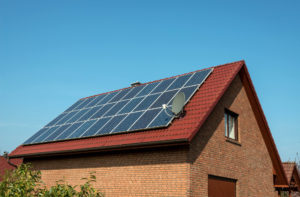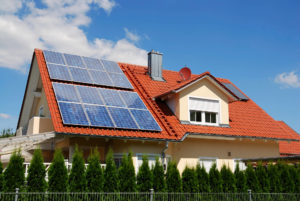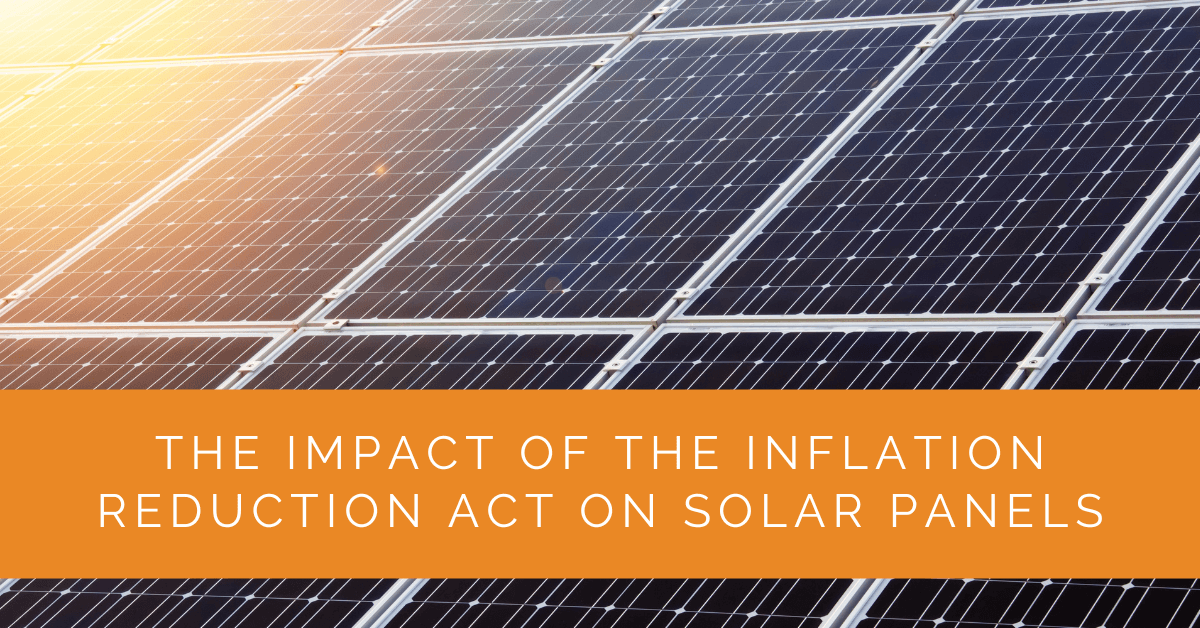The Inflation Reduction Act of 2022 (IRA) is a landmark legislation that has significantly influenced the renewable energy sector, particularly solar energy. The IRA, signed into law by President Joe Biden, has introduced a series of tax credits and incentives that have revolutionized the solar industry. This article will delve into the specifics of the IRA and its implications for solar panels, from tax credits to solar installation and battery storage.
Contents
- 1 Key Takeaways
- 2 The IRA and Solar Energy Tax Credits
- 3 Solar Installation and Battery Storage under the IRA
- 4 Solar Incentives and the Reduction of Greenhouse Gas Emissions
- 5 Tax Credit Monetization and the IRA
- 6 The Future of Solar Energy under the IRA
- 7 Case Study: Embracing the Benefits of the Inflation Reduction Act for Solar Energy Solutions
- 8 Expert Insights From Our Solar Panel Installers About the Impact of the Inflation Reduction Act on Solar Panels
- 9 Experience Solar Excellence with Us!
- 10 Conclusion: The IRA’s Role in Shaping the Solar Energy Landscape
- 11 FAQ
Key Takeaways
- The Inflation Reduction Act of 2022 (IRA) has significantly influenced the solar energy landscape by providing tax credits and incentives for solar installation and battery storage.
- The IRA’s provisions have made solar installation more affordable, leading to a surge in solar installations and promoting the solar industry’s growth.
- By incentivizing the adoption of solar panels and other renewable energy technologies, the IRA is helping to reduce greenhouse gas emissions and promote energy efficiency.
Understanding the IRA and Its Relevance to Solar Energy
The IRA is a comprehensive legislative package that aims to reduce inflation and stimulate economic growth. A key component of the IRA is its focus on clean energy, which includes significant provisions for solar energy. The Act incentivizes homeowners and businesses to install solar panels and invest in renewable energy, reducing greenhouse gas emissions and promoting energy efficiency.
The IRA and Solar Energy Tax Credits
One of the most impactful aspects of the IRA is its extension and expansion of tax credits for solar energy. These tax credits, including the Investment Tax Credit (ITC) and the Production Tax Credit (PTC), have been instrumental in encouraging the adoption of solar panels.
Extension of the Federal Solar Tax Credit
The IRA extends the existing 30% ITC for solar energy property from 2022 to 2032. This means taxpayers who install solar panels on their property can claim a tax credit equal to 30% of the installation cost. This significant incentive has made solar installation more affordable for many homeowners and businesses, leading to a surge in solar panel installations.
Introduction of the Clean Electricity Investment Credit
In addition to extending the ITC, the IRA introduces the Clean Electricity Investment Credit. This new tax credit applies to any electricity-generating facility that has an “anticipated greenhouse gas emissions rate” that is not greater than zero. This includes standalone battery storage technology, further incentivizing the adoption of renewable energy solutions.
The Role of the Clean Electricity Production Credit
The IRA also introduces the Clean Electricity Production Credit, a technology-neutral credit for any electricity generating facility. This credit is designed to incentivize clean electricity production, further promoting the use of solar panels and other renewable energy technologies.

Solar Installation and Battery Storage under the IRA
The IRA has significant implications for solar installation and battery storage, two key components of a comprehensive solar energy system.
Impact of the IRA on Solar Installation
The IRA’s tax credits have made solar installation more affordable for many homeowners and businesses. By reducing the upfront cost of solar panels, the IRA has made investing in renewable energy easier for individuals and companies. This has led to a significant increase in solar installations, contributing to the solar industry’s growth.
Expansion of Tax Credits to Standalone Energy Storage Facilities
Previously, energy storage facilities could only qualify for the ITC if a qualified solar or ITC-qualified renewable electricity generating facility charged at least 75%. The IRA changes this by extending the ITC to standalone energy storage facilities, such as batteries. This means homeowners and businesses can now receive tax credits for investing in energy storage, even if these facilities are not directly connected to solar panels.
Solar Incentives and the Reduction of Greenhouse Gas Emissions
The IRA’s solar incentives are not just about promoting solar installation but also about reducing greenhouse gas emissions and promoting energy efficiency.
The Role of Solar Incentives in Promoting Rooftop Solar
The IRA’s solar incentives have been particularly effective in promoting rooftop solar. By providing tax credits for solar installation, the IRA has made it more affordable for homeowners to install solar panels on their roofs. This has led to a significant increase in rooftop solar installations, which effectively reduce greenhouse gas emissions and promote energy efficiency.
How the IRA Encourages Reduction in Greenhouse Gas Emissions
By incentivizing the adoption of solar panels and other renewable energy technologies, the IRA is helping to reduce greenhouse gas emissions. Solar panels generate electricity without emitting greenhouse gases, making them a clean and sustainable energy source. By promoting solar panels, the IRA is helping to reduce the United States’ carbon footprint and combat climate change.

Tax Credit Monetization and the IRA
The IRA also includes provisions for tax credit monetization, which can help developers of renewable energy projects benefit from the tax credits.
Understanding Tax Credit Monetization
Tax credit monetization is when taxpayers sell their tax credits to another party. This can benefit developers of renewable energy projects, who often cannot utilize large income tax credits.
The IRA’s Provisions for Transferring Tax Credits
The IRA allows a qualified ITC- or PTC-qualified facility owner to transfer the tax credits to an unrelated person. This means that developers of renewable energy projects can sell their tax credits to other taxpayers, making it easier for them to obtain the benefit of the tax credits.
The Future of Solar Energy under the IRA
The IRA has significant implications for the future of solar energy. By providing tax credits and incentives for solar installation and battery storage, the IRA is helping to promote the solar industry’s growth.
Predicted Growth of the Solar Industry
Over the next decade, the solar industry is expected to grow significantly. The IRA’s tax credits and incentives are expected to lead to a surge in solar installations, contributing to the solar industry’s growth.
The IRA’s Long-Term Impact on Solar Energy Tax
The IRA’s impact on solar energy is not just short-term but has significant long-term implications. By providing tax credits and incentives for solar installation and battery storage, the IRA is helping to shape the future of solar energy.
Case Study: Embracing the Benefits of the Inflation Reduction Act for Solar Energy Solutions
Background
At Solar Panels Network USA, we pride ourselves on staying at the forefront of renewable energy innovations. The Inflation Reduction Act (IRA) has provided us with the perfect opportunity to expand our services and offer enhanced benefits to our clients. This case study illustrates how we leveraged the IRA to transform a residential community’s energy consumption.
Project Overview
We were approached by a residential community seeking to reduce their carbon footprint and lower their energy costs. The community consisted of 50 homes, each with a strong interest in renewable energy solutions but concerned about the initial investment required for solar installations.
Implementation
Leveraging the provisions of the Inflation Reduction Act, particularly the extended 30% Investment Tax Credit (ITC) and the new Clean Electricity Investment Credit, we developed a comprehensive solar energy plan for the community. Each homeowner was educated on the financial benefits of the IRA, ensuring they understood how these incentives would reduce their overall costs.
- Initial Assessment: Our team conducted detailed energy assessments for each home, identifying the optimal placement for solar panels and potential energy savings.
- Customized Solar Solutions: Based on the assessments, we designed personalized solar energy systems that included both solar panels and standalone battery storage units.
- Installation: The installation process was streamlined, thanks to the financial relief provided by the IRA. Homeowners could claim a 30% tax credit on their solar installation costs, significantly reducing their financial burden.
- Community Engagement: We organized workshops and informational sessions to ensure all residents were informed and excited about the transition to solar energy.
Results
The implementation of the solar energy systems was a resounding success. Within months, the community saw a dramatic reduction in their energy bills, with an average decrease of 40%. The standalone battery storage units ensured that homes had access to renewable energy even during power outages, further enhancing the reliability and efficiency of their energy consumption.
Additionally, the community’s carbon footprint was significantly reduced. The switch to solar energy prevented approximately 500 tons of CO2 emissions annually, making a substantial positive impact on the environment.
Summary
The Inflation Reduction Act has been instrumental in making solar energy more accessible and affordable. At Solar Panels Network USA, we successfully utilized the IRA’s provisions to help a residential community transition to sustainable energy solutions. This case study highlights the transformative power of the IRA, showcasing how legislative incentives can drive significant environmental and economic benefits.
Expert Insights From Our Solar Panel Installers About the Impact of the Inflation Reduction Act on Solar Panels
As a lead solar installer, I’ve seen firsthand how the Inflation Reduction Act has revolutionized the solar industry. The extension of the 30% Investment Tax Credit has made solar installations much more accessible for homeowners and businesses alike. This significant financial incentive not only reduces the upfront cost but also encourages a broader adoption of renewable energy solutions.
Lead Solar Installer
From a project management perspective, the introduction of the Clean Electricity Investment Credit has been a game-changer. This credit, which applies to both solar installations and standalone battery storage, has allowed us to offer more comprehensive energy solutions to our clients. It’s not just about installing solar panels anymore; it’s about creating a full-scale energy-efficient system that maximizes savings and sustainability.
Senior Project Manager
The Inflation Reduction Act’s focus on clean energy has had a profound impact on reducing greenhouse gas emissions. By promoting the adoption of rooftop solar through substantial tax credits, we are seeing a surge in installations that directly contribute to a cleaner environment. Our clients are not only saving money but also playing a crucial role in combating climate change.
Chief Energy Consultant
Experience Solar Excellence with Us!
Trust in Solar Panels Network USA, where our seasoned experts deliver top-quality solar solutions for homes and businesses nationwide. With a legacy of countless successful installations and a commitment to sustainable energy, we’re your reliable partner in the solar journey. Ready for a brighter, eco-friendly future? Call us now at (855) 427-0058 and harness the power of the sun!
Conclusion: The IRA’s Role in Shaping the Solar Energy Landscape
The Inflation Reduction Act of 2022 is a landmark legislation significantly influencing the solar energy landscape. By providing tax credits and incentives for solar installation and battery storage, the IRA is promoting the solar industry’s growth and helping to reduce greenhouse gas emissions. As we look to the future, the IRA’s impact on solar energy is clear: it is helping to shape a cleaner, more sustainable future.
FAQ
Does the Inflation Reduction Act pay for solar panels?
While the Inflation Reduction Act does not directly pay for solar panels, it provides significant tax credits that can offset the solar installation cost. This includes the extension of the Investment Tax Credit (ITC), which allows taxpayers to claim a tax credit equal to 30% of the solar installation cost.
Does the Inflation Reduction Act increase solar tax credit?
The Inflation Reduction Act extends the 30% Investment Tax Credit (ITC) for solar energy properties from 2022 to 2032. It also introduces the Clean Electricity Investment Credit and the Clean Electricity Production Credit, which are new tax credits designed to incentivize clean electricity production.
What is the Inflation Reduction Act for solar low-income?
The Inflation Reduction Act includes provisions that specifically benefit low-income individuals and communities. For example, the Act allows for an additional tax credit for solar power projects that sell their electricity via community solar projects to low-income individuals. This makes solar energy more accessible and affordable for low-income households.
About the Author
Solar Panels Network USA stands at the forefront of solar energy solutions, driven by a team of seasoned solar engineers and energy consultants. With over decades of experience in delivering high-quality solar installations and maintenance, we are committed to promoting sustainable energy through customer-centric, tailored solutions. Our articles reflect this commitment, crafted collaboratively by experts to provide accurate, up-to-date insights into solar technology, ensuring our readers are well-informed and empowered in their solar energy decisions.

